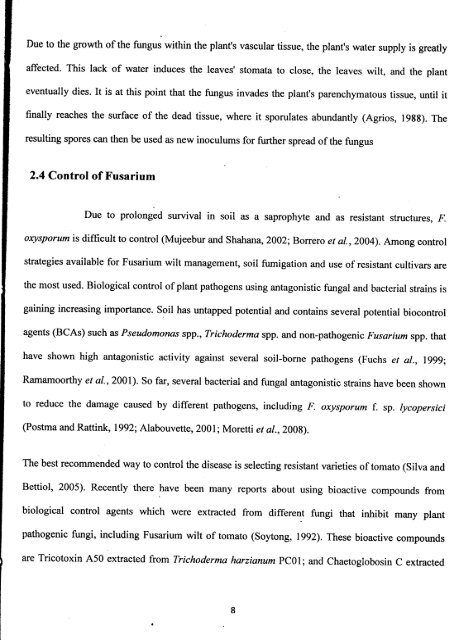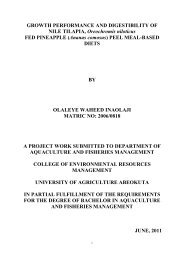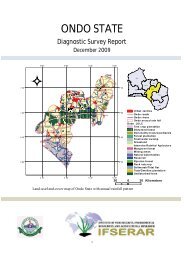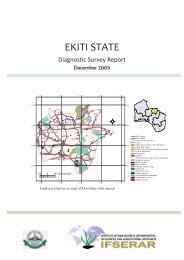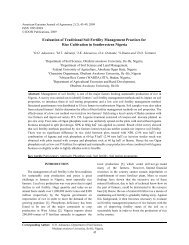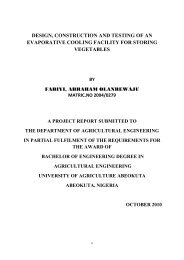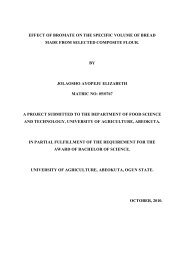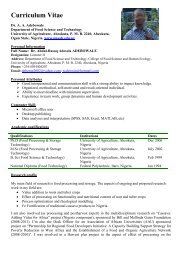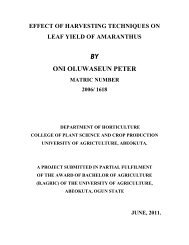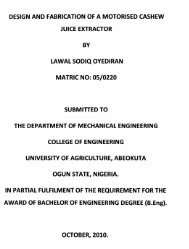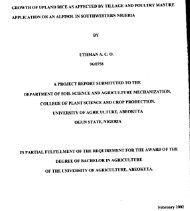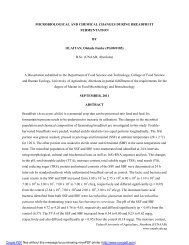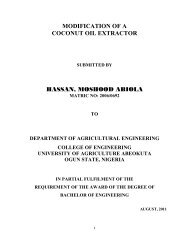SCREENING OF TOMATO ACCESSIONS FOR RESISTANCE TO ...
SCREENING OF TOMATO ACCESSIONS FOR RESISTANCE TO ...
SCREENING OF TOMATO ACCESSIONS FOR RESISTANCE TO ...
You also want an ePaper? Increase the reach of your titles
YUMPU automatically turns print PDFs into web optimized ePapers that Google loves.
Due to the growth of the fungus within the plant's vascular tissue, the plant's water supply is greatly<br />
affected. This lack of water induces the leaves' stomata to close, the leaves wilt, and the plant<br />
eventually dies. It is at this point that the fungus invades the plant's parenchymatous<br />
tissue, until it<br />
finally reaches the surface of the dead tissue, where it sporulates abundantly (Agrios, 1988). The<br />
resulting spores can then be used as new inoculums for further spread of the fungus<br />
Due to prolonged survival in soil as a saprophyte and as resistant structures, F<br />
oxysporum is difficult to control (Mujeebur and Shahana, 2002; Borrero et al., 2004). Among control<br />
strategies available for Fusarium wilt management, soil fumigation and use of resistant cultivars are<br />
the most used. Biological control of plant pathogens using antagonistic<br />
fungal and bacterial strains is<br />
gaining increasing importance. Soil has untapped potential and contains several potential biocontrol<br />
agents (BCAs) such as Pseudomonas spp., Trichoderma spp. and non-pathogenic Fusarium spp. that<br />
have shown high antagonistic activity against several soil-borne pathogens (Fuchs et al., 1999;<br />
Ramamoorthy et aI., 2001). So far, several bacterial and fungal antagonistic strains have been shown<br />
to reduce the damage caused by different pathogens, including F oxysporum f. sp. Iycopersici<br />
(Postma and Rattink, 1992; Alabouvette, 200 I; Moretti et al., 2008).<br />
The best recommended<br />
way to control the disease is selecting resistant varieties of tomato (Silva and<br />
Bettiol, 2005). Recently there have been many reports about using bioactive compounds from<br />
biological control agents which were extracted from different fungi that inhibit many plant<br />
pathogenic fungi, including Fusarium wilt of tomato (Soytong, 1992). These bioactive compounds<br />
are Tricotoxin A50 extracted from Trichoderma harzianum PCO1; and Chaetoglobosin C extracted


